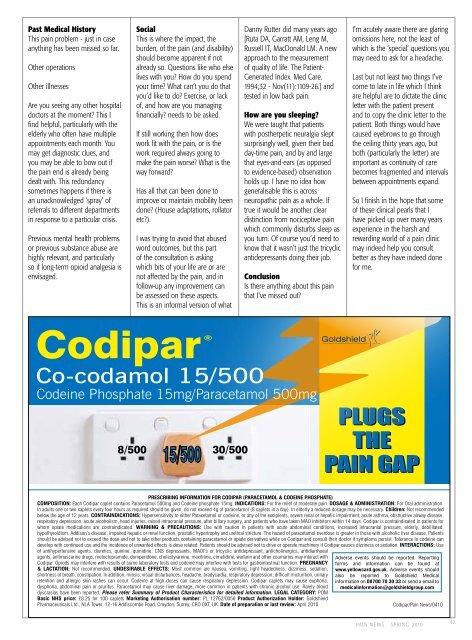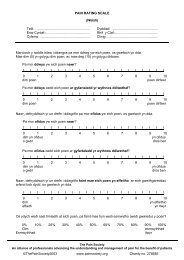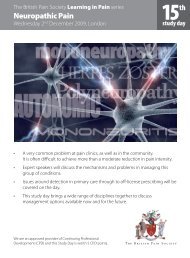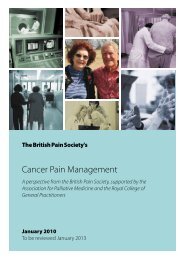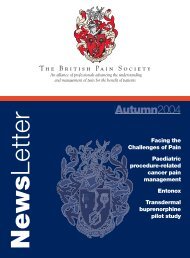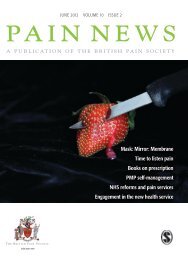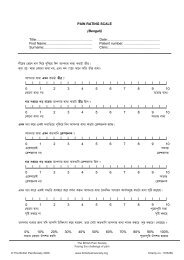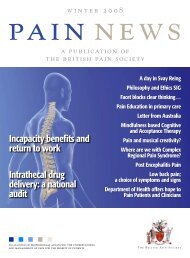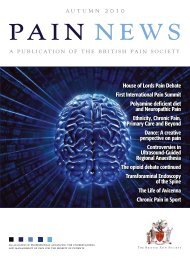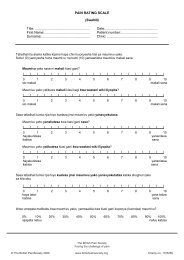Summer 2010 - The British Pain Society
Summer 2010 - The British Pain Society
Summer 2010 - The British Pain Society
Create successful ePaper yourself
Turn your PDF publications into a flip-book with our unique Google optimized e-Paper software.
Past Medical History<br />
This pain problem - just in case<br />
anything has been missed so far.<br />
Other operations<br />
Other illnesses<br />
Are you seeing any other hospital<br />
doctors at the moment? This I<br />
find helpful, particularly with the<br />
elderly who often have multiple<br />
appointments each month. You<br />
may get diagnostic clues, and<br />
you may be able to bow out if<br />
the pain end is already being<br />
dealt with. This redundancy<br />
sometimes happens if there is<br />
an unacknowledged ‘spray’ of<br />
referrals to different departments<br />
in response to a particular crisis.<br />
Previous mental health problems<br />
or previous substance abuse are<br />
highly relevant, and particularly<br />
so if long-term opioid analgesia is<br />
envisaged.<br />
Social<br />
This is where the impact, the<br />
burden, of the pain (and disability)<br />
should become apparent if not<br />
already so. Questions like who else<br />
lives with you? How do you spend<br />
your time? What can’t you do that<br />
you’d like to do? Exercise, or lack<br />
of, and how are you managing<br />
financially? needs to be asked.<br />
If still working then how does<br />
work fit with the pain, or is the<br />
work required always going to<br />
make the pain worse? What is the<br />
way forward?<br />
Has all that can been done to<br />
improve or maintain mobility been<br />
done? (House adaptations, rollator<br />
etc?).<br />
I was trying to avoid that abused<br />
word outcomes, but this part<br />
of the consultation is asking<br />
which bits of your life are or are<br />
not affected by the pain, and in<br />
follow-up any improvement can<br />
be assessed on these aspects.<br />
This is an informal version of what<br />
Danny Rutter did many years ago<br />
[Ruta DA, Garratt AM, Leng M,<br />
Russell IT, MacDonald LM. A new<br />
approach to the measurement<br />
of quality of life. <strong>The</strong> Patient-<br />
Generated Index. Med Care.<br />
1994;32 - Nov(11):1109-26.] and<br />
tested in low back pain.<br />
How are you sleeping?<br />
We were taught that patients<br />
with postherpetic neuralgia slept<br />
surprisingly well, given their bad<br />
day-time pain, and by and large<br />
that eyes-and-ears (as opposed<br />
to evidence-based) observation<br />
holds up. I have no idea how<br />
generalisable this is across<br />
neuropathic pain as a whole. If<br />
true it would be another clear<br />
distinction from nociceptive pain<br />
which commonly disturbs sleep as<br />
you turn. Of course you’d need to<br />
know that it wasn’t just the tricyclic<br />
antidepressants doing their job.<br />
Conclusion<br />
Is there anything about this pain<br />
that I've missed out?<br />
I'm acutely aware there are glaring<br />
omissions here, not the least of<br />
which is the ‘special’ questions you<br />
may need to ask for a headache.<br />
Last but not least two things I've<br />
come to late in life which I think<br />
are helpful are to dictate the clinic<br />
letter with the patient present<br />
and to copy the clinic letter to the<br />
patient. Both things would have<br />
caused eyebrows to go through<br />
the ceiling thirty years ago, but<br />
both (particularly the letter) are<br />
important as continuity of care<br />
becomes fragmented and intervals<br />
between appointments expand.<br />
So I finish in the hope that some<br />
of these clinical pearls that I<br />
have picked up over many years<br />
experience in the harsh and<br />
rewarding world of a pain clinic<br />
may indeed help you consult<br />
better as they have indeed done<br />
for me.<br />
Codipar®<br />
Co-codamol 15/500<br />
Codeine Phosphate 15mg/Paracetamol 500mg<br />
8/500<br />
15/500<br />
30/500<br />
PLUGS<br />
THE<br />
PAIN GAP<br />
PRESCRIBING INFORMATION FOR CODIPAR (PARACETAMOL & CODEINE PHOSPHATE)<br />
COMPOSITION: Each Codipar caplet contains Paracetamol 500mg and Codeine phosphate 15mg. INDICATIONS: For the relief of moderate pain. DOSAGE & ADMINISTRATION: For Oral administration.<br />
In adults one or two caplets every four hours as required should be given, do not exceed 4g of paracetamol (8 caplets in a day). In elderly a reduced dosage may be necessary. Children: Not recommended<br />
below the age of 12 years. CONTRAINDICATIONS: Hypersensitivity to either Paracetamol or codeine, or any of the excipients, severe renal or hepatic impairment; acute asthma, obstructive airway disease,<br />
respiratory depression, acute alcoholism, head injuries, raised intracranial pressure, after biliary surgery, and patients who have taken MAO inhibitors within 14 days. Codipar is contraindicated in patients for<br />
whom opiate medications are contraindicated. WARNING & PRECAUTIONS: Use with caution in patients with acute abdominal conditions, increased intracranial pressure, elderly, debilitated,<br />
hypothyroidism, Addison’s disease, impaired hepatic or renal function, prostatic hypertrophy and urethral stricture. <strong>The</strong> hazard of paracetamol overdose is greater in those with alcoholic liver disease. Patients<br />
should be advised not to exceed the dose and not to take other products containing paracetamol or opiate derivatives while on Codipar and consult their doctor if symptoms persist. Tolerance to codeine can<br />
develop with continued use and the incidence of unwanted effects is dose related. Patients should be advised not to drive or operate machinery if Codipar causes dizziness or sedation. INTERACTIONS: Use<br />
of antihypertensive agents, diuretics, quinine, quinidine, CNS depressants, MAOI’s or tricyclic antidepressant, anticholinergics, antidiarrhoeal<br />
agents, antimuscarine drugs, metoclopramide, domperidone, cholestyramine, mexilitine, cimetidine, warfarin and other coumarins may interact with<br />
Codipar. Opiods may interfere with results of some laboratory tests and codeine may interfere with tests for gastrointestinal function. PREGNANCY<br />
& LACTATION: Not recommended. UNDESIRABLE EFFECTS: Most common are nausea, vomiting, light headedness, dizziness, sedation,<br />
shortness of breath, constipation. In addition, miosis, visual disturbances, headache, bradycardia, respiratory depression, difficult micturition, urinary<br />
retention and allergic skin rashes can occur. Codeine at high doses can cause respiratory depression. Codipar caplets may cause euphoria,<br />
dysphoria, abdominal pain or pruritus. Paracetamol may cause liver damage, more common in patients with chronic alcohol use. Rarely blood<br />
dyscrasias have been reported. Please refer Summary of Product Characteristics for detailed information. LEGAL CATEGORY: POM<br />
Basic NHS price: £8.25 for 100 caplets Marketing Authorisation number: PL 12762/0056 Product Authorization Holder: Goldshield<br />
Pharmaceuticals Ltd., NLA Tower, 12-16 Addiscombe Road, Croydon, Surrey, CRO OXT, UK. Date of preparation or last review: April <strong>2010</strong><br />
Adverse events should be reported. Reporting<br />
forms and information can be found at<br />
www.yellowcard.gov.uk. Adverse events should<br />
also be reported to Goldshield Medical<br />
information on 08700 70 30 33 or send a email to<br />
medicalinformation@goldshieldgroup.com<br />
Codipar/<strong>Pain</strong> News/0410<br />
Codipar-GIP-O<br />
PAI N N E W S S P R I N G <strong>2010</strong><br />
47


